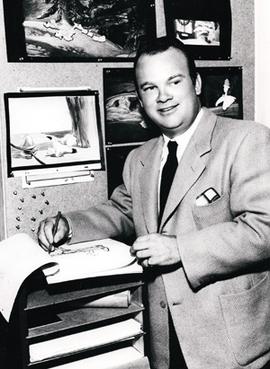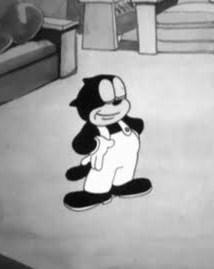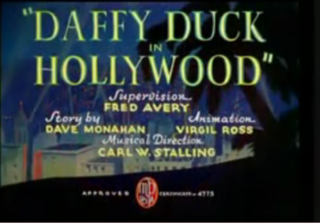
Looney Tunes is an American animated franchise produced and distributed by Warner Bros. It began as a series of short films that originally ran from 1930 to 1969, concurrently with its partner series Merrie Melodies, during the golden age of American animation. Following a revival in the late 1970s, new shorts were released as recently as 2014. The two series introduced a large cast of characters, including Bugs Bunny, Daffy Duck, and Porky Pig. The term Looney Tunes has since been expanded to also refer to the characters themselves.

Frederick Bean "Tex" Avery was an American animator, cartoonist, director, and voice actor. He was known for directing and producing animated cartoons during the golden age of American animation. His most significant work was for the Warner Bros. and Metro-Goldwyn-Mayer studios, where he was crucial in the creation and evolution of famous animated characters such as Bugs Bunny, Daffy Duck, Porky Pig, Elmer Fudd, Droopy, Screwy Squirrel, The Wolf, Red Hot Riding Hood, and George and Junior.

Porky in Wackyland is a 1938 Warner Bros. Looney Tunes animated short film, directed by Bob Clampett. The short was released on September 24, 1938, and stars Porky Pig venturing out to find the last do-do bird, which he finds in Wackyland, a land that makes no sense located in Darkest Africa.

Gold Diggers of '49 is a 1935 Warner Bros. theatrical animated cartoon short in the Looney Tunes series. This film is the first animated cartoon directed by Tex Avery for Warner Bros., and the second Warners cartoon to feature the character Porky Pig. The star is Beans the Cat, with Porky Pig as the father of Beans' fiancée, Little Kitty. Looking for suitable characters from the Warners stable to embellish, Avery took two child characters from the previous short I Haven't Got a Hat, turned them into adults, and, as Steve Schlesinger writes, "set the studio on track to making adult cartoons."

Beans the Cat is an animated cartoon character in the Warner Bros. Cartoons series of cartoons from 1935–1936. Beans was the third Warner Bros cartoon character star after Bosko and Buddy. He is voiced by Billy Bletcher and occasionally by Tommy Bond. He was created by director Friz Freleng. The character was featured in nine cartoons made in 1935 and 1936.
Warner Bros. Cartoons, Inc. was an American animation studio, serving as the in-house animation division of Warner Bros. during the Golden Age of American animation. One of the most successful animation studios in American media history, it was primarily responsible for the Looney Tunes and Merrie Melodies series of animated short films. The characters featured in these cartoons, including Bugs Bunny, Daffy Duck, and Porky Pig, are among the most famous and recognizable characters in the world. Many of the creative staff members at the studio, including directors and animators such as Chuck Jones, Friz Freleng, Robert McKimson, Tex Avery, Robert Clampett, Arthur Davis, and Frank Tashlin, are considered major figures in the art and history of traditional animation.

A Wild Hare is a 1940 American animated comedy short film directed by Tex Avery, produced by Leon Schlesinger, and distributed by Warner Bros. as part of the Merrie Melodies series. The film was released on July 27, 1940, and features Elmer Fudd and Bugs Bunny, the latter making what is considered his first official appearance.

The Heckling Hare is a Merrie Melodies cartoon, released on July 5, 1941, and featuring Bugs Bunny and a dopey dog named Willoughby. The cartoon was directed by Tex Avery, written by Michael Maltese, animated by soon-to-be director Robert McKimson, and with musical direction by Carl W. Stalling. In a style that was becoming typical of the Bugs character, he easily outwitted and tormented his antagonist through the short, his only concern being what to do next to the dog.
The Night Watchman is a 1938 Warner Bros. Merrie Melodies cartoon directed by Chuck Jones. The short was released on November 19, 1938.

I Love to Singa is a 1936 Warner Bros. Merrie Melodies animated cartoon directed by Tex Avery. The short was released on July 18, 1936.

Daffy Duck & Egghead is a 1938 Warner Bros. Merrie Melodies cartoon produced in 1937 and directed by Tex Avery. The cartoon was released on January 1, 1938, and stars Daffy Duck and Egghead.

Thugs with Dirty Mugs is a 1939 Warner Bros. Merrie Melodies cartoon directed by Tex Avery. The short was released on May 6, 1939.
Of Fox and Hounds is a 1940 Warner Bros. Merrie Melodies directed by Tex Avery. The short was released on December 7, 1940, and introduces Willoughby the Dog. Avery performed the voice of Willoughby, and Mel Blanc voiced George the Fox and the bear's yells. The short is an attempt to duplicate the success of the 1940 Bugs Bunny short A Wild Hare by giving another anthropomorphic animal the same unflappable demeanor. The names of Tex Avery, Dave Monohan, Carl W. Stalling, and possibly Charles McKimson intentionally draft numbers in the credits.
Dangerous Dan McFoo is a 1939 Warner Bros. Merrie Melodies cartoon directed by Tex Avery. The short was released on July 15, 1939.
Land of the Midnight Fun is a 1939 Warner Bros. Merrie Melodies cartoon supervised by Tex Avery. The short was released on September 23, 1939.
A Feud There Was is a 1938 Warner Bros. Merrie Melodies cartoon directed by Tex Avery. The short was released on September 24, 1938, and features the fourth appearance of an early version of Elmer Fudd.

Daffy Duck in Hollywood is a 1938 Warner Bros. Merrie Melodies animated short directed by Tex Avery. The cartoon was released on December 12, 1938, and stars Daffy Duck. The short is Avery's last Daffy Duck cartoon.

Cinderella Meets Fella is a 1938 Warner Bros. Merrie Melodies directed by Tex Avery and written by Tedd Pierce. The short was released on July 23, 1938, and features the third appearance of an early version of Elmer Fudd.
Detouring America is a 1939 Warner Bros. Merrie Melodies cartoon directed by Tex Avery. The short was released on August 26, 1939.











